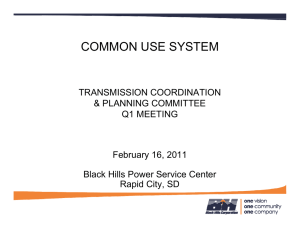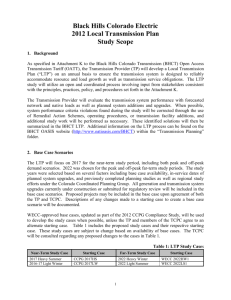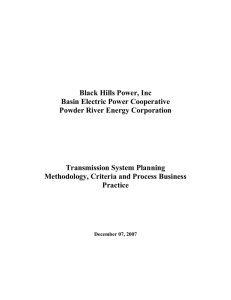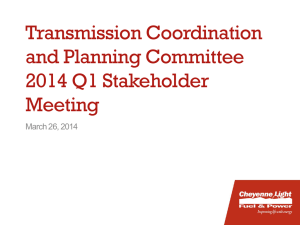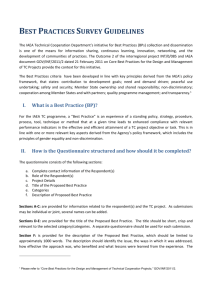Q1 Meeting Presentation (March 5, 2008) Updated:2009-01-05 12:11 CS
advertisement
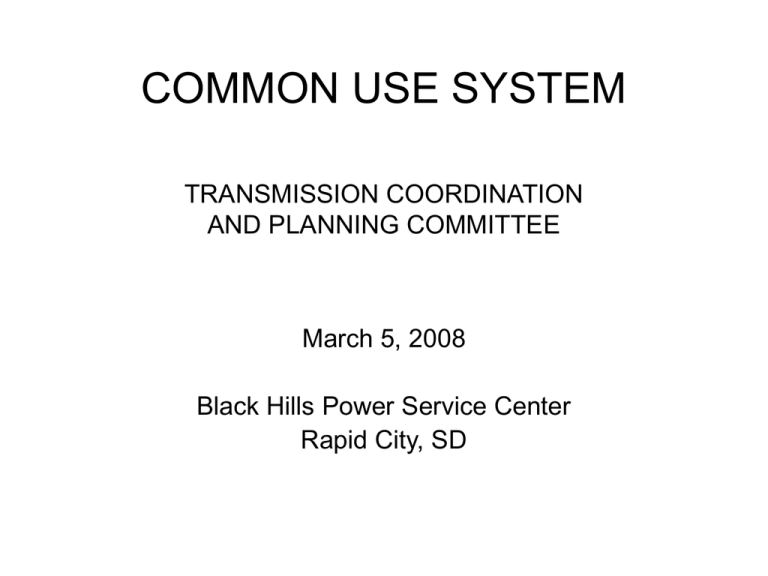
COMMON USE SYSTEM TRANSMISSION COORDINATION AND PLANNING COMMITTEE March 5, 2008 Black Hills Power Service Center Rapid City, SD FERC 890 Overview • The intent of this Order is to remedy opportunities for undue discrimination and address deficiencies in the pro forma open access transmission tariff (“pro forma OATT”). • The Commission directed all transmission providers to develop a transmission planning process that satisfies nine planning principles with an emphasis on coordination, openness, transparency and stakeholder input. Attachment K & TCPC • • • • • Principle 1 – Coordination: Requires appropriate communication among transmission providers, transmission-providing neighbors, state authorities, customers, and other stakeholders. Principle 2 – Openness: Requires that Transmission Planning meetings be open to all affected parties, including but not limited to all transmission and interconnection customers, state commissions and other stakeholders. Principle 3 – Transparency: Requires disclosure of basic methodology, criteria, assumptions, process and data that underlie transmission system plans. Must be published and consistently applied. Principle 4 - Information Exchange: Requires transmission customers to submit information on projected loads and resources. Equivalent information must be provided by transmission customers to ensure effective planning and comparability. Principle 5 – Comparability: Requires the Transmission Provider to develop a transmission plan, after considering the data and comments supplied by customers and other stakeholders, that: 1) meets the specific service requests of its transmission customers; and 2) provides comparable treatment to similarly situated customers (network and retail native load). Attachment K & TCPC • • • • • Principle 6 - Dispute Resolution: Requires an Alternate Dispute Resolution (ADR) process be available to manage disputes that arise from the planning process. Must address both substantive and procedural planning disputes. Three steps should be included in the ADR process: 1) Negotiation, 2) Mediation, and 3) Arbitration. Principle 7 - Regional Participation :Requires Transmission Providers to coordinate with interconnected systems to: 1) share system plans to ensure they are simultaneously feasible and otherwise use consistent assumptions and data, and 2) identify system enhancements that could relieve congestion or integrate new resources. Principle 8 - Economic Planning Studies: Requires planning to address both reliability and economic considerations. Principle 9 - Cost Allocation for New Projects: Requires the planning process to address cost allocation for joint projects, economic projects, and projects that do not fit into existing OATT cost allocation principles. TCPC: The Transmission Provider will work with TCPC to identify the study objectives, assumptions, study plan and pertinent scenarios that should be studied in order to meet various stakeholder needs SOC and Confidentiality • FERC Standards of Conduct • TCPC Charter – Confidentiality – TCPC members agree not to discuss their committee activities or information obtained through the committee with the press. – In discussing TCPC activities in public forums, members agree to discuss only their ideas, concerns, or positions regarding committee activities and information and not to characterize those of other members. Typical Timeline - LTP Study Cycle Quarter Planning Steps Data Collection TCPC Meetings X Q1 Study Scope & Scenario Development Open X Optional Q2 Technical Study X Q3 Closed X Q4 Decision & Reporting LTP Study Process Data Collection, Study Scope and Scenario Development Load and Resource Forecast, Point-to-Point Projections, Demand Resources Identify Study Objective, Define Assumptions, Develop Study Scope and Scenarios TCPC = Transmission Coordination and Planning Committee TCPC Input As Requested/Needed WECC and/or SubRegional Entities Technical Study Develop Base Cases and Perform Simulations Identify Mitigation or Solutions to Reliability Criteria Violations Analyze Results and Identify Reliability Criteria Violations YES Another Scenario? Re-Run Simulations with Solutions TCPC Input NO Document Solutions, ID Advantages or Disadvantages to Each Solution YES Reliability Criteria Met? Analyze Results and ID Reliability Problems Sub-Regional Review, WECC Project Review Process NO Decision And Reporting Identify Best Solution a.Selection Criteria b.Advantages/Disadvantages Prioritize Into Company Business and Strategic Plan Construction and Rate Base Support CUS Coordination Committee and TP Publish Report TCPC Input Timing of Other Public Input Determined by TCPC TCPC Input Sub-Regional Review, WECC Project Review Process Northern Tier Transmission Group Colorado Coordinated Planning Group MONTANA WYOMING ARVADA SHERIDAN TONGUE RIVER CARR DRAW DRY FORK WYODAK BUFFALO HUGHES BARBER CREEK PUMPKIN BUTTES DONKEY CREEK RENO OSAGE TECKLA LOOKOUT YELLOW CREEK LANGE SOUTH RAPID DC TIE WESTHILL YELLOWCAKE TO SPENCE S DAKOTA NEBRASKA CASPER M. MILE DAVE JOHNSTON CUS PAC STEGALL BEPW WAPA
